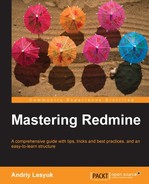Book Description
Redmine is an open source gem for project management, and this book shows you how to exploit its features to the max. Written as a practical tutorial, it’s also the perfect reference guide to have by your side.
- Use Redmine in the most effective manner and learn to master it
- Become an expert in the look and feel with behavior and workflow customization
- Utilize the natural flow of chapters, from initial and simple topics to advanced ones
In Detail
Redmine is well-known as one of the best open source project management applications. But, it's also one of the best project hosting and issue tracking solutions. In addition it incorporates Wiki, repository management, forums, time tracking, and more. This book reveals the power of Redmine and manifests its exceptional flexibility and customizability.
Mastering Redmine is a comprehensive guide which covers a wide variety of topics: from configuration to writing simple plugins, from issue reporting to managing issue lifecycles, from writing simple Wiki pages to designing rich web content using the Wiki syntax, from quick installation to deep customization, and more.
This book resembles a learning tutorial. It imitates the self-learning process so that you first understand the basics before we dig deeper into the advanced concepts.
You will first read about possible setups. Then, you will choose an appropriate setup to install and configure. The book runs through the main features of Redmine and shows how it can be effectively used as project management, issue and time tracking solution. Once you are familiar with all the essential features of Redmine, you will start exploring advanced concepts such as integration with other applications, customizing Redmine, and using various Redmine plugins.
This book will help you master Redmine by unleashing it's core functionality .
Table of Contents
- Mastering Redmine
- Table of Contents
- Mastering Redmine
- Credits
- About the Author
- About the Reviewers
- www.PacktPub.com
- Preface
- 1. Getting Familiar with Redmine
- 2. Installing Redmine
- Preface
- Installing Redmine from the package
- Installing Redmine from sources
- Using TurnKey Redmine appliance
- Using BitNami Redmine stack
- Maintaining Redmine
- Summary
- 3. Configuring Redmine
- 4. Issue Tracking
- 5. Managing Projects
- 6. Time Tracking
- 7. Text Formatting
- 8. Access Control and Workflow
- 9. Personalization
- 10. Plugins and Themes
- 11. Customizing Redmine
- Index
